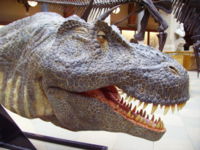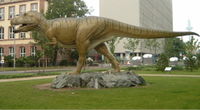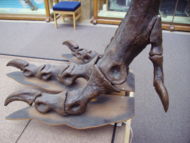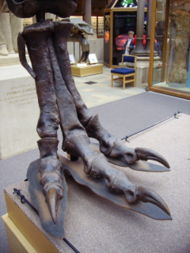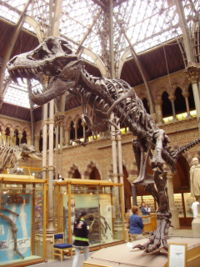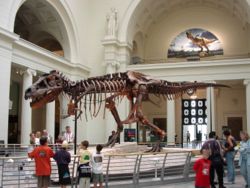Tyrannosaurus
2007 Schools Wikipedia Selection. Related subjects: Dinosaurs
| iTyrannosaurus |
||||||||||||||||||||
|---|---|---|---|---|---|---|---|---|---|---|---|---|---|---|---|---|---|---|---|---|
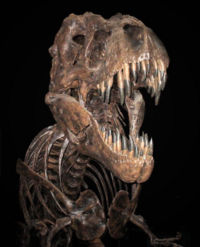 Fossil skeleton at
National Museum of Natural History, Washington, D.C. |
||||||||||||||||||||
|
|
||||||||||||||||||||
|
Extinct (fossil)
|
||||||||||||||||||||
| Scientific classification | ||||||||||||||||||||
|
||||||||||||||||||||
|
|
||||||||||||||||||||
| Tyrannosaurus rex Osborn, 1905 |
||||||||||||||||||||
|
|
||||||||||||||||||||
|
Manospondylus gigas |
Tyrannosaurus ( IPA pronunciation /taɪˌɹænəˈsɔrəs/ or /tɪ-/; from the Greek "τυραννόσαυρος", meaning 'tyrant lizard') is a genus of tyrannosaurid theropod dinosaur. The species Tyrannosaurus rex, commonly abbreviated to T. rex, is one of the dinosaurs most often featured in popular culture around the world. It hails from what is now western North America. Some scientists consider the slightly older Tarbosaurus bataar from Asia to represent a second species of Tyrannosaurus, while others maintain Tarbosaurus as a separate genus.
Like other tyrannosaurids, Tyrannosaurus was a bipedal carnivore with a massive skull balanced by a long, heavy tail. Relative to the large and powerful hindlimbs, Tyrannosaurus forelimbs were small and retained only two digits. Although other theropods rivaled or exceeded T. rex in size, it was the largest known tyrannosaurid and one of the largest known land predators, measuring over 12 metres (40 feet) in length and weighing as much as an elephant.
Fossils of some T. rex have been found in North American rock formations dating to the very end of the Cretaceous Period (late Maastrichtian stage, 65 million years ago); it was among the last dinosaurs to exist prior to the Cretaceous-Tertiary extinction event. More than 30 specimens of T. rex have now been identified, some nearly complete, which has allowed significant research into many aspects of its biology, including its life history and biomechanics. The feeding habits and potential speed of T. rex remain controversial.
Description
Tyrannosaurus rex was one of the largest land carnivores of all time, about 12 to 13 meters (40 to 43.3 feet) long, and 4.5-5 m (14-16 ft) tall, when fully-grown. Mass estimates have varied widely over the years, from more than 7,200 kilograms (8 short tons), to less than 4,500 kg (5 tons), with most modern estimates ranging between 5,400 and 6,800 kg (between 6 and 7.5 tons).
The largest known T. rex skulls measure up to 1.5 m (5 ft) in length. Compared to other theropods, the skull was heavily modified. The skull was extremely wide posteriorly, with a narrow snout, allowing some degree of binocular vision. Some of the bones, such as the nasals, were fused, preventing movement between them. Large fenestrae (openings) in the skull reduced weight and provided areas for muscle attachment. The bones themselves were massive, as were the serrated teeth which, rather than being bladelike, were oval in cross-section. Like other tyrannosaurids, T. rex displayed marked heterodonty, with the premaxillary teeth at the front of the upper jaw closely-packed and D-shaped in cross-section. Large bite marks found on bones of other dinosaurs indicate that these teeth could penetrate solid bone. T. rex had the greatest bite force of any animal. Worn or broken teeth are often found, but unlike those of mammals, tyrannosaurid teeth were continually replaced throughout the life of the animal.
The neck of T. rex formed a natural S-shaped curve like that of other theropods, but was short and muscular to support the massive head. The two-fingered forelimbs were very small relative to the size of the body, but heavily built. In contrast, the hindlimbs were among the longest in proportion to body size of any theropod. The tail was heavy and long, sometimes containing over forty vertebrae, in order to balance the massive head and torso. To compensate for the immense bulk of the animal, many bones throughout the skeleton were hollow. This reduced the weight of the skeleton while maintaining much of the strength of the bones.
Classification
Tyrannosaurus is the type genus of the superfamily Tyrannosauroidea, the family Tyrannosauridae, and the subfamily Tyrannosaurinae. Other members of the tyrannosaurine subfamily include the North American Daspletosaurus and the Asian Tarbosaurus, both of which have occasionally been synonymized with Tyrannosaurus. Tyrannosaurids were once commonly thought to be descendants of earlier large theropods such as megalosaurs and carnosaurs, although more recently they were reclassified with the generally smaller coelurosaurs.
In 1955, Soviet paleontologist Evgeny Maleev named a new species, Tyrannosaurus bataar, from Mongolia. By 1965, this species had been renamed Tarbosaurus bataar. Despite the renaming, many phylogenetic analyses have found Tarbosaurus bataar to be the sister taxon of Tyrannosaurus rex, and it has often been considered an Asian species of Tyrannosaurus. However, a recent redescription of the skull of Tarbosaurus bataar has shown that it was much narrower than that of Tyrannosaurus rex and that during a bite, the distribution of stress in the skull would have been very different, closer to that of Alioramus, another Asian tyrannosaur. A related cladistic analysis found that Alioramus, not Tyrannosaurus, was the sister taxon of Tarbosaurus, which, if true, would suggest that Tarbosaurus and Tyrannosaurus should remain separate.
Other tyrannosaurid fossils found in the same formations as T. rex were originally classified as separate taxa, including Aublysodon and "Albertosaurus" megagracilis. However, these fossils are now universally considered to belong to juvenile T. rex. A small but nearly complete skull from Montana, 60 cm (2 ft) long, may be an exception. This skull was originally classified as a species of Gorgosaurus ("G." lancensis) by Charles W. Gilmore in 1946, but was later referred to a new genus, Nanotyrannus. Opinions remain divided on the validity of N. lancensis. Many paleontologists consider the skull to belong to a juvenile T. rex. There are minor differences between the two species, including the higher number of teeth in N. lancensis, which lead some scientists to recommend keeping the two genera separate until further research or discoveries clarify the situation.
Manospondylus controversy
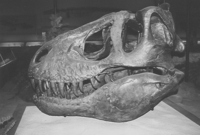
The first fossil specimen which can be attributed to Tyrannosaurus rex consists of two partial vertebrae (one of which has been lost) found by Edward Drinker Cope in 1892 and described as Manospondylus gigas. Osborn recognized the similarity between M. gigas and T. rex as early as 1917 but, due to the fragmentary nature of the Manospondylus vertebrae, he could not synonymize them conclusively.
Controversy erupted in June 2000 after more tyrannosaur bones unearthed in South Dakota by the Black Hills Institute were found at the type locality of M. gigas and judged to represent further remains of the same individual. These more recently-discovered remains clearly belong to T. rex. According to the rules of the International Commission on Zoological Nomenclature, the system that governs the scientific naming of animals, Manospondylus gigas should therefore have priority over Tyrannosaurus rex, because it was named first. However, in the Fourth Edition of the International Code of Zoological Nomenclature, which took effect on January 1, 2000, Chapter 6, Article 23.9 states that "the prevailing usage must be maintained" when "the senior synonym or homonym has not been used as a valid name after 1899" and "the junior synonym or homonym has been used for a particular taxon, as its presumed valid name, in at least 25 works, published by at least 10 authors in the immediately preceding 50 years..." Tyrannosaurus rex more than qualifies as the valid name under these conditions and is considered a nomen protectum ("protected name") under the ICZN, making Manospondylus gigas a nomen oblitum ("forgotten name").
Paleobiology
As with all dinosaurs known only from the fossil record, much of Tyrannosaurus biology, including behaviour, coloration, ecology, and physiology, remains unknown. However, many new specimens have been discovered in the last twenty years, which has allowed some informed speculation on growth patterns, sexual dimorphism, biomechanics, and metabolism.
Life history
The identification of several specimens as juvenile Tyrannosaurus rex has allowed scientists to document ontogenetic changes in the species, estimate the lifespan, and determine how quickly the animals would have grown. The smallest known individual (LACM 28471, the so-called "Jordan theropod") is estimated to have weighed only 29.9 kg (66 lb), while the largest, such as FMNH PR2081 ("Sue") most likely weighed over 5400 kg (6 short tons). Histologic analysis of T. rex bones showed LACM 28471 had aged only 2 years when it died, while "Sue" was 28 years old, an age which may have been close to the maximum for the species.
Histology has also allowed the age of other specimens to be determined. Growth curves can be developed when the ages of different specimens are plotted on a graph along with their mass. A T. rex growth curve is S-shaped, with juveniles remaining under 1800 kg (2 short tons) until approximately 14 years of age, when body size began to increase dramatically. During this rapid growth phase, a young T. rex would gain an average of 600 kg (1600 lb) a year for the next four years. At 18 years of age, the curve plateaus again, indicating that growth slowed dramatically. For example, only 600 kg (1,300 lb) separated the 28-year-old "Sue" from a 22-year-old Canadian specimen (RTMP 81.12.1). This sudden change in slope of the growth curve may indicate physical maturity, a hypothesis which is supported by the discovery of medullary tissue in the femur of a 16 to 20-year-old T. rex from Montana (MOR 1125, also known as "B-rex"). Medullary tissue is found only in female birds during ovulation, indicating that "B-rex" was of reproductive age. Other tyrannosaurids exhibit extremely similar growth curves, although with lower growth rates corresponding to their lower adult sizes.
Over half of the known T. rex specimens appear to have died within six years of reaching sexual maturity, a pattern which is also seen in other tyrannosaurs and in large, long-lived birds and mammals today. These species are characterized by high infant mortality rates, followed by relatively low mortality among juveniles. Mortality increases again following sexual maturity, partly due to the stresses of reproduction. One study suggests that the rarity of juvenile T. rex fossils is due in part to low juvenile mortality rates; the animals were not dying in large numbers at these ages, and so were not often fossilized. However, this rarity may also be due to the incompleteness of the fossil record or to the bias of fossil collectors towards larger, more spectacular specimens.
Sexual dimorphism
As the number of specimens increased, scientists began to analyze the variation between individuals and discovered what appeared to be two distinct body types, or morphs, similarly to some other theropod species. As one of these morphs was more solidly built, it was termed the 'robust' morph while the other was termed 'gracile.' Several morphological differences associated with the two morphs were used to analyze sexual dimorphism in Tyrannosaurus rex, with the 'robust' morph usually suggested to be female. For example, the pelvis of several 'robust' specimens seemed to be wider, perhaps to allow the passage of eggs.
It was also thought that 'robust' animals possessed a reduced chevron on the first tail vertebra, also ostensibly to allow eggs to pass out of the reproductive tract, as had been reported for crocodiles. However, in recent years, evidence for sexual dimorphism has been weakened. A full-sized chevron was discovered on the first tail vertebra of "Sue," an extremely robust individual, indicating that this feature could not be used to differentiate the two morphs. In 2005, it was reported that crocodiles exhibited no sexual dimorphism in chevron anatomy either, further weakening the case for dimorphism between T. rex sexes. As T. rex specimens have been found from Saskatchewan to New Mexico, differences between individuals may be more indicative of geographic variation rather than sexual dimorphism. The differences could also be age-related, with 'robust' individuals being older animals.
Only a single T. rex specimen has been conclusively shown to belong to a specific gender. Examination of "B-rex," the geologically oldest known specimen, demonstrated the preservation of soft tissue within several bones. Some of this tissue has been identified as medullary tissue, a specialized tissue grown only in modern birds as a source of calcium for the production of eggshell during ovulation. As only female birds lay eggs, medullary tissue is only found naturally in females, although males are capable of producing it when injected with female reproductive hormones like estrogen. This strongly suggests that "B-rex" was female, and that she died during ovulation. The presence of medullary tissue also provides further evidence of the close evolutionary relationship between birds and theropod dinosaurs.
Posture
Like many bipedal dinosaurs, Tyrannosaurus rex was historically depicted as a 'living tripod', with the body at 45 degrees or less from the vertical and the tail dragging along the ground, similar to a kangaroo. This concept dates from Joseph Leidy's 1865 reconstruction of Hadrosaurus, the first to depict a dinosaur in a bipedal posture. Henry Fairfield Osborn, former president of the American Museum of Natural History (AMNH) in New York City, who believed the creature stood upright, further reinforced the notion after unveiling the first complete T. rex skeleton in 1915. It stood in this upright pose for nearly a century, until it was dismantled in 1992. By 1970, scientists realized this pose was incorrect and could not have been maintained by a living animal, as it would have resulted in the dislocation or weakening of several joints, including the hips and the articulation between the head and the spinal column. Despite its inaccuracies, the AMNH mount inspired similar depictions in many films and paintings (such as Rudolph Zallinger's famous mural The Age Of Reptiles in Yale University's Peabody Museum of Natural History) until the 1990s, when films such as Jurassic Park introduced a more accurate posture to the general public. Modern representations in museums, art, and film show T. rex with its body approximately parallel to the ground and tail extended behind the body to balance the head. There have been suggestions that, when chasing prey, the animal might have raised its neck into an 'S' position (much like that of a bird) in order to avoid problems in changing direction; this was discussed in The Truth About Killer Dinosaurs. This way, the head might not always have been jutting forwards.
Arms
When Tyrannosaurus rex was first discovered, the humerus was the only element of the forelimb known. For the initial mounted skeleton as seen by the public in 1915, Osborn substituted longer, three-fingered forelimbs like those of Allosaurus. However, a year earlier, Lawrence Lambe described the short, two-fingered forelimbs of the closely-related Gorgosaurus. This strongly suggested that T. rex had similar forelimbs, but this hypothesis was not confirmed until the first complete T. rex forelimbs were identified in 1989, belonging to MOR 555 (the "Wankel rex"). The remains of "Sue" also include complete forelimbs. T. rex 'arms' are very small relative to overall body size, measuring only 1 m (3 ft 3 in) long. However, they are not vestigial but instead show large areas for muscle attachment, indicating considerable strength. This was recognized as early as 1906 by Osborn, who speculated that the forelimbs may have been used to grasp a mate during copulation. It has also been suggested that the forelimbs were used to assist the animal in rising from a prone position. Another possibility is that the forelimbs held struggling prey while it was dispatched by the tyrannosaur's enormous jaws. This hypothesis may be supported by biomechanical analysis. T. rex forelimb bones exhibit extremely thick cortical bone, indicating that they were developed to withstand heavy loads. The biceps brachii muscle of a full-grown Tyrannosaurus rex was capable of lifting 199 kg (438 lb) by itself; this number would only increase with other muscles (like the brachialis) acting in concert with the biceps. A T. rex forearm also had a reduced range of motion, with the shoulder and elbow joints allowing only 40 and 45 degrees of motion, respectively. In contrast, the same two joints in Deinonychus allow up to 88 and 130 degrees of motion, respectively, while a human arm can rotate 360 degrees at the shoulder and move through 165 degrees at the elbow. The heavy build of the arm bones, extreme strength of the muscles, and limited range of motion may indicate a system designed to hold fast despite the stresses of a struggling prey animal.
Feathers
In 2004, the scientific journal Nature published a report describing an early tyrannosauroid, Dilong paradoxus, from the famous Yixian Formation of China. As with many other theropods discovered in the Yixian, the fossil skeleton was preserved with a coat of filamentous structures which are commonly recognized as the precursors of feathers. It has also been proposed that Tyrannosaurus and other closely-related tyrannosaurids had such protofeathers. However, rare skin impressions from adult tyrannosaurids in Canada and Mongolia show pebbly scales typical of other dinosaurs. While it is possible that protofeathers existed on parts of the body which have not been preserved, a lack of body covering is consistent with modern multi-ton animals such as elephants, hippopotamus, and most species of rhinoceros, all of which lack hair over most of their bodies. As animals increase in size, their ability to retain heat increases due to their decreasing surface area-to- volume ratios. Therefore, as large animals evolve in or disperse into warm climates, a coat of fur or feathers loses its selective advantage for thermal insulation and can instead become a disadvantage, as the insulation traps excess heat inside the body, possibly overheating the animal. Protofeathers may also have been secondarily lost during the evolution of large tyrannosaurids like Tyrannosaurus, especially in warm Cretaceous climates. Some scientists speculate that young tyrannosaurs may have had a feathery down, similar to modern bird chicks, but this is purely guesswork.
Tyrannosaurus warm-blooded?
Tyrannosaurus has been at the centre of the warm-blooded versus cold-blooded debate ever since its beginnings with the paleontologist Robert T. Bakker. Like many other theropods, Tyrannosaurus is thought to have been warm-blooded due to its heightened levels of activity. To have been able to capture prey actively for example, it would have been useful to the creature to be warm-blooded. T. rex also has anatomical features distinctly similar to birds, which are warm-blooded. However, since the birth of the theory that Tyrannosaurus was in fact a scavenger, the theory that Tyrannosaurus was warm-blooded has been cast into doubt. Although Bakker provided some important factual evidence, paleontologists are still divided on the issue.
Feeding strategies

Most debate about Tyrannosaurus centers on its feeding patterns and locomotion. One paleontologist, noted hadrosaur expert Jack Horner, claims that Tyrannosaurus was exclusively a scavenger and did not engage in active hunting at all. Horner has only presented this in an official scientific context once, while mainly discussing it in his books and in the media. His hypothesis is based on the following: Tyrannosaurs have large olfactory bulbs and olfactory nerves (relative to their brain size). These suggest a highly developed sense of smell, allegedly used to sniff out carcasses over great distances. Tyrannosaur teeth could crush bone, a skill perhaps used to extract as much food ( bone marrow) as possible from carcass remnants, usually the least nutritious parts. Since at least some of Tyrannosaurus's prey could move quickly, evidence that it walked instead of ran could indicate that it was a scavenger.
Most scientists who have published on the subject since insist that Tyrannosaurus was both a predator and a scavenger, taking whatever meat it could acquire depending on the opportunity that was presented. Modern carnivores such as lions and hyenas will often scavenge what other predators have killed, suggesting that tyrannosaurs may also have done so.
Some other evidence exists that suggests hunting behaviour in Tyrannosaurus. The ocular cavities of tyrannosaurs are positioned so that the eyes would point forward, giving the dinosaur binocular vision. A scavenger might not need the advanced depth perception that stereoscopic vision affords; in modern animals, binocular vision is found primarily in predators.
When examining Sue, paleontologist Pete Larson found a broken and healed fibula and tail vertebrae, scarred facial bones and a tooth from another Tyrannosaurus embedded in a neck vertebra. If correct, it might be strong evidence for aggressive behaviour between tyrannosaurs but whether it would be competition for food and mates or active cannibalism is unclear. However, further recent investigation of these purported wounds has shown that most are infections rather than injuries (or simply damage to the fossil after death) and the few injuries are too general to be indicative of intraspecific conflict. In the Sue excavation site, an Edmontosaurus annectens skeleton was also found with healed tyrannosaur-inflicted scars on its tail. The fact that the scars seem to have healed suggests active predation instead of scavenging a previous kill. Another piece of evidence is a Triceratops found with bite marks on its ilium. Again, these were inflicted by a tyrannosaur and they too appear healed.
For all intents and purposes, the 'scavenging debate' does not actually exist in any scientific context. However, there have been conflicting studies regarding the extent to which Tyrannosaurus could run and exactly how fast it might have been; speculation has suggested speeds up to 70 km/h (45 mph) or even more. However, according to James Farlow, a palaeontologist at Indiana-Purdue University in Fort Wayne, Indiana, "If T. rex had been moving fast and tripped, it would have died." If it tripped and fell while running, a tumbling tyrannosaur's torso would have slammed into the ground at a deceleration of 6g (six times the acceleration due to gravity, or about 60 m/s²). See Locomotion, below.
Some argue that if Tyrannosaurus were a scavenger, another dinosaur had to be the top predator in the Amerasian Upper Cretaceous. Top prey were the larger marginocephalians and ornithopods. The other tyrannosaurids share so many characteristics that only small dromaeosaurs remain as feasible top predators. In this light, scavenger hypothesis adherents have suggested that the size and power of tyrannosaurs allowed them to steal kills from smaller predators.
Locomotion
Scientists who think that Tyrannosaurus was able to run slowly point out that hollow Tyrannosaur bones and other features that would have lightened its body may have kept adult weight to a mere 5 tons or so, or that other animals like ostriches and horses with long, flexible legs are able to achieve high speeds through slower but longer strides. Additionally, some have argued that Tyrannosaurus had relatively larger leg muscles than any animal alive today, which could have enabled fast running (40–70 km/h or 25–45 mph).
Some old studies of leg anatomy and living animals suggested that Tyrannosaurus could not run at all and merely walked. The ratio of femur (thigh bone) to tibia (shank bone) length (greater than 1, as in most large theropods) could indicate that Tyrannosaurus was a specialized walker, like a modern elephant. In addition, it had tiny 'arms' that could not have stopped the dinosaur's fall, had it stumbled while running; standard estimates of Tyrannosaurus weight at 6 to 8 tons would produce a lethal impact force, should it have fallen. It should be noted, however, that giraffes have been known to gallop at 50 km/h (31 mph). At those speeds, the animal risks breaking a leg or worse, which can be fatal even when the accident occurs in a 'safe' environment, such as a zoo. If it could run, Tyrannosaurus may have been a risk-taker, in much the same way as animals alive today are. Yet estimates of leg bone strength in Tyrannosaurus show that its legs were little, if any stronger, than those of elephants, which are relatively limited in their top speed and do not ever become 'airborne', as would happen in running.
Walking proponents estimate the top speed of Tyrannosaurus at about 17 km/h (11 mph). This is still faster than the most likely prey species that co-existed with tyrannosaurs; the hadrosaurs and ceratopsians. In addition, some predation advocates claim that tyrannosaur running speed is not important, since it may have been slow but better designed for speed than its probable prey or it may have used ambush tactics to attack faster prey animals.
The most recent research on Tyrannosaurus locomotion does not specify how fast Tyrannosaurus may have run, but admits that there is little capacity to narrow down speeds further than a range from 17 km/h (11 mph), which would be only walking or slow running, to 40 km/h (25 mph), which would be moderate-speed running. For example, a paper in Nature used a mathematical model (validated by applying it to two living animals, alligators and chickens) to gauge the leg muscle mass needed for fast running (over 25 mph / 40 km/h). They found that proposed top speeds in excess of 40 km/h (25 mph) were unfeasible, because they would require very large leg muscles (more than approximately 40–86% of total body mass.) Even moderately fast speeds would have required large leg muscles. This discussion is difficult to resolve, as it is unknown how large the leg muscles were. If they were smaller, only ~11 mph (18 km/h) walking/jogging might have been possible.
History
Henry Fairfield Osborn, president of the American Museum of Natural History, named Tyrannosaurus rex in 1905. The generic name is derived from the Greek words τυραννος (tyrannos, meaning "tyrant") and σαυρος (sauros, meaning "lizard"). Osborn used the Latin word rex, meaning "king", for the specific name. The full binomial therefore translates to "tyrant lizard king," emphasizing the animal's size and perceived dominance over other species of the time.
Earliest finds
The vertebrae named Manospondylus by Cope in 1892 can be considered the first known specimen of Tyrannosaurus rex. Barnum Brown, assistant curator of the American Museum of Natural History, found the second Tyrannosaurus skeleton in Wyoming in 1900. This specimen was originally named Dynamosaurus imperiosus in the same paper in which Tyrannosaurus rex was described. Had it not been for page order, Dynamosaurus would have become the official name. The original "Dynamosaurus" material resides in the collections of the Natural History Museum, London.
In total, Barnum Brown found five Tyrannosaurus partial skeletons. Brown collected his second Tyrannosaurus in 1902 and 1905 in Hell Creek, Montana. This is the holotype used to describe Tyrannosaurus rex Osborn, 1905. In 1941 it was sold to the Carnegie Museum of Natural History in Pittsburgh, Pennsylvania. Brown's fourth and largest find, also from Hell Creek, is on display in the American Museum of Natural History in New York.
Named skeletons
Another Tyrannosaurus, nicknamed "Stan", in honour of amateur paleontologist Stan Sacrison, was found in the Hell Creek Formation near Buffalo, South Dakota, in the spring of 1987. After 30,000 hours of digging and preparing, a 65% complete skeleton emerged. Stan is currently on display in the Black Hills Museum of Natural History Exhibit in Hill City, South Dakota, after an extensive world tour. This tyrannosaur, too, was found to have many bone pathologies, including broken and healed ribs, a broken (and healed) neck and a spectacular hole in the back of its head, about the size of a Tyrannosaurus tooth. Both Stan and Sue were examined by Peter Larson.
Susan Hendrickson, amateur paleontologist, discovered the most complete (more than 90%) and, until 2001 the largest, Tyrannosaurus fossil skeleton known in the Hell Creek Formation near Faith, South Dakota, on August 12, 1990. This Tyrannosaurus, now named "Sue" in her honor, was the object of a legal battle over its ownership. In 1997 this was settled in favour of Maurice Williams, the original land owner, and the fossil collection was sold at auction for USD 7.6 million. It has now been reassembled and is currently exhibited at the Field Museum of Natural History. Based on a study of 'her' fossilized bones, Sue died at 28 years of age, having reached full size at 19 years of age. Researchers report that a subadult and a juvenile skeleton were found in the same quarry as Sue; this lends evidence to the possibility that tyrannosaurs ran in packs or other groups.
In 2001, a 50% complete skeleton of a juvenile Tyrannosaurus was discovered in the Hell Creek Formation in Montana, by a crew from the Burpee Museum of Natural History of Rockford, Illinois. Dubbed " Jane the Rockford T-Rex," the find was initially considered the first known skeleton of the pygmy tyrannosaurid Nanotyrannus but subsequent research has revealed that it is more likely a juvenile Tyrannosaurus. It is the most complete and best preserved juvenile example known to date. Jane has been examined by Jack Horner, Pete Larson, Robert Bakker, Greg Erickson and several other renowned paleontologists, because of the uniqueness of her age. Jane is currently on exhibit at the Burpee Museum of Natural History in Rockford, Illinois.
Also in 2001, Dr. Jack Horner discovered a specimen of T. rex around 15% larger than "Sue". Dubbed C. rex (or "Celeste" after Jack's wife), this specimen is currently under study.
Latest news
In the March 2005 Science magazine, Mary Higby Schweitzer of North Carolina State University and colleagues announced the recovery of soft tissue from the marrow cavity of a fossilized leg bone, from a 68 million-year-old Tyrannosaurus. The bone had been intentionally, though reluctantly, broken for shipping and then not preserved in the normal manner, specifically because Schweitzer was hoping to test it for soft tissue. Designated as the Museum of the Rockies specimen 1125, or MOR 1125, the dinosaur was previously excavated from the Hell Creek Formation. Flexible, bifurcating blood vessels and fibrous but elastic bone matrix tissue were recognized. In addition, microstructures resembling blood cells were found inside the matrix and vessels. The structures bear resemblance to ostrich blood cells and vessels. Whether an unknown process, distinct from normal fossilization, preserved the material, or the material is original, the researchers do not know, and they are careful not to make any claims about preservation. If it is found to be original material, any surviving proteins may be used as a means of indirectly guessing some of the DNA content of the dinosaurs involved, because each protein is typically created by a specific gene. The absence of previous finds may merely be the result of people assuming preserved tissue was impossible, therefore simply not looking. Since the first, two more tyrannosaurs and a hadrosaur have also been found to have such tissue-like structures.
In a press release on April 7, 2006, Montana State University revealed that it possessed the largest Tyrannosaurus skull yet discovered. Discovered in the 1960s and only recently reconstructed, the skull measures 59 inches (150 cm) long compared to the 55.4 inches (141 cm) of “Sue’s” skull, a difference of 6.5%.
Appearances in popular culture
Since it was first described in 1905, Tyrannosaurus has become the most widely-recognized dinosaur in popular culture. It is the only dinosaur which is commonly referred to by its scientific name, Tyrannosaurus rex, among the general public, and the scientific abbreviation T. rex (often mistakenly spelled "T-Rex") has also come into wide usage. Museum exhibits featuring T. rex are very popular; an estimated 10,000 visitors flocked to Chicago's Field Museum on the opening day of its "Sue" exhibit in 2003. T. rex has appeared numerous times on television and in movies, notably The Lost World, King Kong, Jurassic Park, and The Land Before Time. A number of books and comic strips, including Calvin and Hobbes, have also featured Tyrannosaurus, which is typically portrayed as the biggest and most terrifying carnivore of all (with the exception of Dinosaurs where the character Roy is portrayed as dim-witted and barely able to chew a lunch that's already accepted its fate as food). At least one musical group, the band T. Rex, is named after the species, as is The Hives' third album, Tyrannosaurus Hives. Tyrannosaurus-related toys, video games, and other merchandise remain popular. Various businesses have capitalized on the popularity of Tyrannosaurus rex by using it in advertisements.

